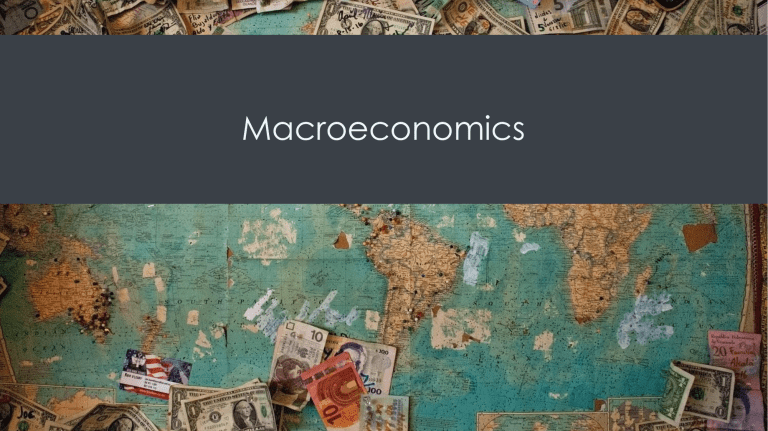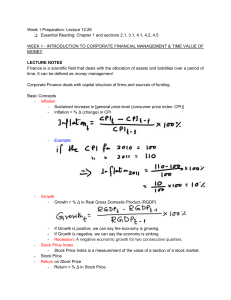Copy-MACRO 7 Macroeconomic+Measures-Unemployment+and+Inflation (1)
advertisement

Macroeconomics Inflation • Hyperinflation: an extremely high rate of inflation, in the 100s or 1000s percent per year • Inflation: a general and ongoing rise in the level of prices in an economy Table 1. Price Comparisons, 1970 and 2014 Items 1970 2014 Pound of ground beef $0.66 $4.16 Pound of butter $0.87 $2.93 Movie ticket $1.55 $8.17 Sales price of new home (median) $22,000 $280,000 New car $3,000 $32,531 Gallon of gasoline $0.36 $3.36 Average hourly wage for a manufacturing worker $3.23 $19.55 Per capita GDP $5,069 $53,041.98 Calculating Inflation with Index Numbers • • • • • • Base Year: arbitrary year whose value as an index number is defined as 100; inflation from the base year to other years can easily be seen by comparing the index number in the other year to the index number in the base year— i.e., 100; so, if the index number for a year is 105, then there has been exactly 5% inflation between that year and the base year Index Number: a unit-free measure of an economic indicators; index numbers are based on a value of 100, which makes it easy to measure percent changes Inflation Rate: the percentage change in some price index Market Basket: hypothetical collection of goods and services (or more precisely, the quantities of each good or service) consumers typically buy Price Indices: essentially the weighted average of prices of a certain type of good or service; price indices are created to calculate the inflation rate, i.e. the percent change in prices over time Price Level: the average of prices Index Numbers • • • A price index is essentially the weighted average of prices of a certain type of good or service Price indices can measure a narrow range of goods and services or a broader range of goods and services Price indices are created to help calculate the percent change in prices over time The Consumer Price Index Consumer Price Index: the average price of the goods and services typically purchased by urban consumers The Eight Major Categories in the Consumer Price Index 1. Food and beverages 2. Housing 3. Apparel 4. Transportation 5. Medical Care 6. Recreation 7. Education and communication 8. Other goods and services Shortcomings of the Consumer Price Index as a Measure of the Cost of Living • • • Core Inflation Index: version of the CPI excluding volatile economic components like energy and food prices. Improved Quality/New Goods Bias: As the quality of goods improves over time, and as new goods become invented, the prices of those goods naturally increase reflecting their increased value; the result is that the CPI overstates the cost of living since some of the price increases it measures represent increases in value, not cost. Substitution Bias: As one good or service becomes more expensive relative to others, consumers tend to substitute away from the more expensive item towards the cheaper item; this means that the weights used to calculate the CPI are no longer accurate, causing the CPI to overstate the cost of living. Shortcomings in the CPI as a Measure of the Cost of Living • • • • A core inflation index is typically calculated by taking the CPI and excluding volatile economic variables. The cost of living represents how much it costs for a person to feel that his or her consumption provides an equal level of satisfaction or utility. Substitution bias tends to overstate the rise in a consumer’s true cost of living. The CPI tends to understate consumers’ standard of living, as measured by nominal income/CPI. The GDP Deflator and Other Major Price Indices • • • Employment Cost Index: estimate of the average cost of labor compensation to employers, including wages, salaries and fringe benefits. GDP Deflator: price index which measures the average price of all goods and services included in GDP; used to convert nominal into real GDP. Producer Price Index: price index based on prices paid for supplies and inputs by producers of goods and services. The GDP Deflator and Producer Price Index • Problems with Inflation • 401(k): a defined contribution retirement program to which the employee and often the employer contribute • Nominal Interest Rate: the actual interest rate charged on a loan • Pension: a defined benefit retirement payment • Real Interest Rate: the interest rate after inflation is taken into account; the nominal interest rate minus the rate of inflation Confusion over Inflation Inflation can cause three types of problems: 1. Blurred price signals 2. Unintended redistributions of purchasing power 3. Difficulties in long-term planning Unintended Redistributions of Purchasing Power • • • People who are hurt by inflation include those who are holding a lot of cash When inflation happens, the buying power of cash is diminished Cash is only an example of a more general problem: anyone who has financial assets invested in a way that the nominal return does not keep up with inflation will tend to suffer from inflation Benefits of Low Inflation • • • • An annual inflation rate of 2%, 3%, or 4% is a long way from a national crisis If variability in inflation rates is a problem, then moderate and high inflations are more likely to have significant variability than are low inflations Low inflation is also better than deflation which occurs with severe recessions Moderate inflation may help the economy by making wages in labor markets more flexible Quick Review • • • • • • • • • Define and differentiate between employed, unemployed, and being in or out of the labor force How do you calculate labor force percentages and the unemployment rate? Explain historical patterns and trends of unemployment in the U.S Evaluate global unemployment rates What is cyclical unemployment? What is the relationship between sticky wages and employment using various economic arguments? What is frictional unemployment and structural unemployment? What is natural unemployment? What is the relationships between the natural rate of employment and potential real GDP, productivity, and public policy. More Quick Review • • • • • • • What is an example of inflation? Explain What is a price index is? How do you compute one? How do you calculate inflation rates using price indices? Using Consumer Price Index (CPI), how do you calculate U.S. inflation rates What are the major shortcomings of the CPI as a measure of the cost of living? Explain how the substitution bias and the quality improvement/new goods bias causes the CPI to overstate the cost of living Contrast the CPI with other price indices, including the PPI and GDP Deflator More More Quick Review • • • What are the ways inflation can blur the perception of supply and demand? How can inflation cause redistributions of purchasing power Explain the possible economic benefits of inflation




